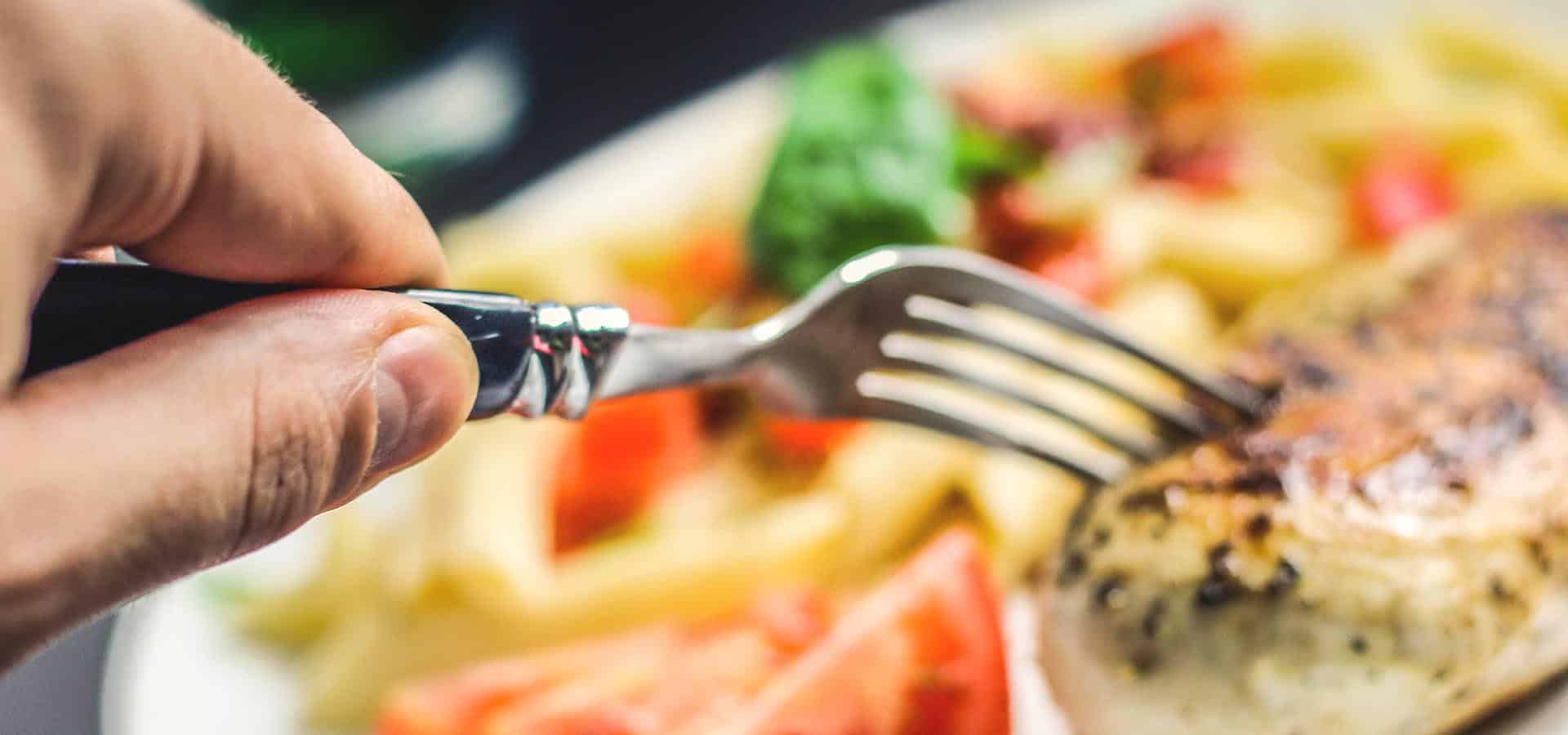
Homemade Bounty Bars
July 5, 2020
Healthy Lunch Box Ideas
July 27, 2020When we think of our basic physical needs as humans, we might think of our need for oxygen, water, sleep, shelter, and of course, food.
O ur bodies have this incredible ability to send us signals or cues when one of our needs is not met, such as thirst, sleepiness, and hunger. Hunger is described as “a feeling of discomfort or weakness caused by a lack of food, coupled with the desire to eat”. When we think of hunger in this way, we often only associate it with physical hunger, but we may also feel a desire to eat without being physically hungry.
Unfortunately, diet culture tells us that we should only eat when physically hungry and sometimes not even then, for example with intermittent fasting! It’s important to realize that responding to hunger builds trust with your body and meets your basic human needs. It is also very common and normal to eat for reasons that have nothing to do with physical hunger. Let’s explore the different types of hunger we may experience so that we can better understand our motivations for eating throughout the day, what we are feeling, and how to truly give our bodies what they need. When starting out, take a moment to identify which of the following hungers you are experiencing when you reach for a meal or snack.

Physical Hunger
This type of hunger is your body’s way of letting you know that it needs energy/fuel from food.
Possible signs that you may be physically hungry:
- You haven’t eaten in over 2-3 hours, or your last meal/snack was quite small/unbalanced
- You start thinking about food or looking at the time to determine when your next meal/snack will be
- You’re feeling low energy or tired, start yawning
- You’re feeling a lack of concentration or an inability to focus
- Your stomach feels empty, or is even growling
How to address it:
- The signs above are indicators that your body needs a re-up of energy and nutrients, it needs FOOD
- If possible, try to have a meal or snack to address your need for food/what your body asking for
- Try to incorporate at least a protein-rich food and some carbohydrates in this meal or snack to make it more satisfying
- Keeping snacks on hand throughout the day can help to ensure you can address physical hunger when it arises and that you will never become overly physically hungry
It's important to note that if you are not used to eating regularly or eating enough throughout the day, your physical hunger cues may be absent or unreliable. If you often don't feel physically hungry, this doesn't necesarily mean that your body doesn't need fuel, it means that we might need to rely more on practical hunger until our physical hunger cues return - learn more about practical hunger below.
If we ignore physical hunger for too long, it can result in more significant symptoms, such as feeling lightheaded, nauseated, irritable, weak, tired, or dizzy. Putting it off for too long can also result in increased cravings for refined carbohydrates, resorting to the next available food item to suppress the discomfort, regardless of what that may be or how that food makes you feel, and/or overeating at the next meal or snack.


Mouth Hunger
Good ol’ cravings, most of us know them well. Your body’s main need here is satisfaction, pleasure and enjoyment. Mouth hunger is driven by the taste and texture of foods. Diet culture tells us that cravings are a bad thing and that giving into your cravings is a sign of weakness or lack of motivation. It's important to know that responding to cravings is not a bad thing and I actually encourage it! Restricting, controlling and avoiding your favourite foods or the foods that you are craving often backfires. It may result in more intense cravings, eating a bunch of alternative foods that aren’t as satisfying, or feeling out of control around that particular food, ultimately eating more than what would have made you feel good.
Signs that you may be experiencing mouth hunger (cravings):
- You’re wanting a very specific taste, texture, or food item
- You just finished eating or ate not too long ago, but are thinking about food again
- Your favourite foods have suddenly become available (e.g. donuts brought into the office)
- You just saw a food advertisement or someone eating something that you enjoy
- You feel that the food is off limits/restricted, which makes you want it more
How to address it:
- First, check to ensure that you aren’t also experiencing physical hunger. Consider how long it’s been since you last ate, if it has been more than 2 hours then you may actually be physically hungry. If you’re physically hungry or feeling low energy, your body can often crave refined carbohydrates (sugar) to get a quick source of energy. If we use a donut only for example to address that physical hunger, you might find that you’re back to feeling the same way soon after. Try having a filling snack or meal first, perhaps in combination with the food that you’re craving, to address your body’s need for energy.
- If it truly is just a craving, ask yourself what it is specifically that you’re craving (e.g. creamy, sweet, salty, crunchy, spicy, fried). What is it about that food that would satisfy you?
- We want to ensure that mouth hunger is addressed with something that truly does satisfy you. If it isn’t satisfying, it will likely result in eating a variety of different things, hoping that the next will address it, but eventually eating what you wanted in the first place.
- Giving yourself permission to enjoy all foods is a huge part of developing a positive relationship with food. There is no such thing as a “good” or “bad” food as all foods play a role in promoting our overall health and well-being. For example, enjoying a donut with a friend might promote your social and emotional well-being by providing you with comfort, happiness, and pleasure.
- Once you’ve decided what it is that you’re looking for (e.g. something crunchy, salty, creamy, sweet), consider how this food makes you feel or has made you feel in the past. There is sometimes an opportunity to satisfy the craving with a food that will also make you feel physically well. For example, if I’m craving something sweet and creamy but I know that ice cream gives me a stomachache, would yogurt with peaches satisfy me instead? If I’m craving something crunchy and salty, but BBQ chips often give me a headache, would popcorn with butter/salt do the trick?
- If a more nutrient-dense option wouldn’t be satisfying, it is completely okay to go for what it is that you truly want. Remember that all foods fit in a healthy diet. In this case, truly savour it and enjoy/taste each bite, without guilt, shame, or judgement. The more you can savour and enjoy each bite, the more pleasure and satisfaction you will get, ultimately better addressing your craving.

Emotional Hunger
That “I just need a cookie” to get through this stressful workday or “let’s see what else is in the fridge” walk to the kitchen because you’re bored-type hunger. Emotional hunger is when we use food to comfort, distract, numb, avoid, or cope with a negative or unwanted emotion.
Signs that it may be emotional hunger:
- You’re feeling a negative emotion that you no longer want to feel (e.g. stress, boredom, anxiety, loneliness)
- You are looking to use food to comfort, cope with, avoid or numb how you are currently feeling
- You think that food will make you feel better in the moment
- You find that food has helped you to cope with this negative feeling in the past
- You’re not physically hungry or really craving any specific food, it might just be whatever is available to you at the time
How to address it:
- Just like with mouth hunger, we want to ensure that physical hunger isn’t playing into what we think might be emotional hunger. For example, did you eat breakfast today, did you have enough protein at your meals throughout the day, did you have an afternoon snack? Sometimes not eating enough during the day can lead to what might feel like emotional eating in the evening but is simply your body trying to make up for the lack of food earlier on in the day.
- There is nothing wrong with emotional eating as food can be an easily accessible luxury and source of pleasure in our lives. Food can definitely be one of our coping strategies, but we also want to ensure that have other coping strategies for our emotions in our toolbox and that eating is not our only strategy.
- Consider what coping strategies you have in your toolbox to address these negative emotions you experience. How do you typically handle stress, anxiety, boredom, sadness, loneliness?
- It’s also important to note that food often doesn’t address the underlying cause of how you’re feeling. You may notice that as soon as you're finished your snack, you're back to feeling just as bored, stressed, or anxious as before. So instead, let's see if there are strategies that could truly address the underlying emotion or root cause of how you’re feeling.
- Start by making a list of all the emotions that you experience that lead to emotional eating for you. Beside each emotion, make a list of non-food coping strategies that you could also use as alternatives to eating.
- Example: stress – deep breathing, stretching, meditating, going for a walk, calling a friend or family member to vent, journaling about how you're feeling, dancing to your favourite music, tackling a task that is causing you stress, taking a bath/shower
- Example: boredom – if you’re not feeling stimulated, what would be another activity that you could be more stimulating? Painting, crossword puzzles, dancing, knitting, cleaning, going for a walk, reading.
- Next time you experience emotional hunger, ask yourself what your underlying emotion is and if eating will meet your unmet need, or perhaps there is another activity or coping strategy you could try that might make you feel better overall.


Practical Hunger
This one is a little bit more obvious as we may not feel hungry, have a specific craving, or be using food to cope with our emotions, but we may be eating because it is practical for our schedule that day. This type of hunger is not a “listen to your body” or “listen to your gut” type of hunger, it asks you to consider the specific circumstances you are in and eat with a plan.
Signs that it may be practical hunger:
- You are eating because you have time now and know that you won’t be able to eat when you are physically hungry later
- You have been dieting or restricting your intake for a long time that you don’t have reliable physical hunger cues yet
- You have lost your appetite due to illness, mental health struggles, or caffeine intake for example, but know that your body still needs nourishment
- You don’t feel hungry for breakfast in the morning but know that without breakfast, you may have low energy all morning and may be overly hungry at lunch
- You are going into a long meeting, work function, social event, or experience where you won’t be able to eat or food will not be available, or maybe your child is napping or you have a break at work and now is the perfect time to nourish yourself
How to address it:
- Ideally, we would be able to eat whenever we experience early signs of physical hunger, but this is not always realistic - we might be busy or we may not yet have reliable hunger cues
- If you do notice your hunger cues, pay attention to how often you typically become hungry and use this information to map out your eating schedule for the day ahead so that you can eat every few hours in between other responsibilities
- For example, if I typically get hungry every 4 hours, I may plan to eat breakfast before leaving for work at 7:30am (even though I’m not hungry), then I may have a snack around 10am because I know I won’t have time to eat lunch until 1pm and will definitely be hungry by 11:30am if I don’t have a snack. Next, I may incorporate an afternoon snack on my commute home from work at 4pm because I won’t be able to eat dinner until 7pm. This is where we use practical hunger to ensure we do not become too physically hungry during periods where we cannot eat.
- Hammond. (2020). Energy and Metabolism. UBC Lecture.
- Shaw, W. & Cannon, C. (2017). Types of Hunger. Craving Change.
- Miller, S. (2016, April 01). The Science of Hunger: How to Control It and Fight Cravings. Retrieved July 04, 2020, from https://www.livescience.com/54248-controlling-your-hunger.html
- Wheatley, S. D., & Whitaker, M. J. (2019). Why do people overeat? Hunger, psychological eating and type 2 diabetes. Practical Diabetes, 36(4), 136. doi:10.1002/pdi.2232
Written by Liz Powell, RD and Joy Tang
References:





